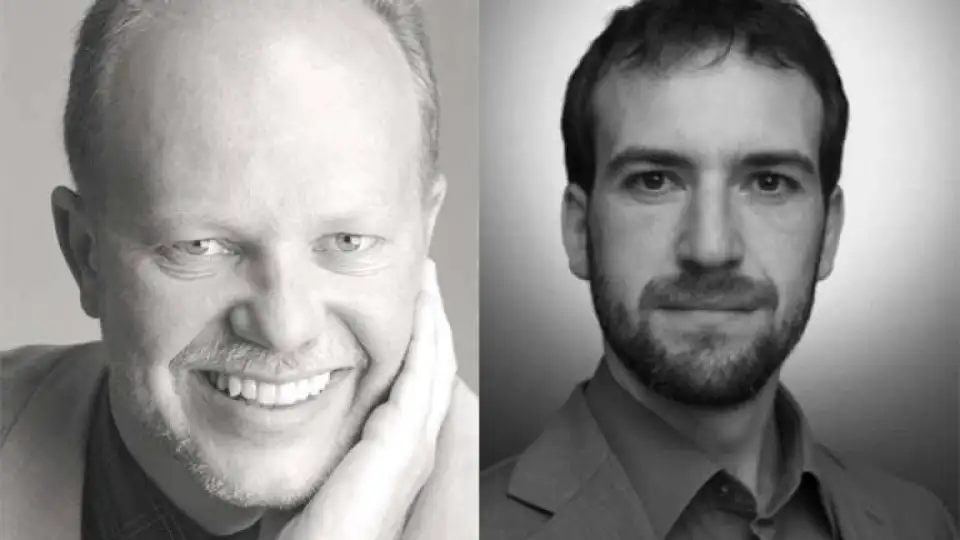
I’ve been a fan of Günter Lang’s work since 2011 when, as a Passive House newbie, I attended the International Passive House Conference in Innsbruck, Austria that Günter helped host in his leadership role with Passive House Austria. Günter later conducted a couple barnstorming tours of North America, sharing his guitar-toting, irreverent brand of Passive House evangelism, including his claim that “sex in a Passive House is safe sex because of low CO2.” He’s a pioneer of Passive House practice in Austria, an agent for change in buildings and climate, and a font of ideas for creative ways to catalyze Passive House market transformation. Along those lines, he and his son and colleague Markus Lang have most recently launched “passathon” featured in the interview below. I got the chance to connect with Günter and Markus a few weeks ago. Please enjoy!
Zack Semke: Could you introduce yourselves and tell us about your work?
Günter Lang: My name is Günter Lang. I’m Director of Operations from LANG consulting, a small consulting office focused on Passive House exclusively. It was started nineteen years ago in 2001 with the first certified Passive House in Austria, which we built for ourselves. At about the same time I also started the Passive House method conversation in Austria, first in Upper Austria where our house is situated, and next for all of Austria. I’ve worked on that for over 17 years. I’ve also been involved in research projects for new Passive House buildings and especially for retrofit Passive House projects. We created the first Passive House retrofits in Austria—a single-family house, multifamily house, and school. All three projects were realized in 2005.
Markus Lang: I am Markus Lang, son and colleague of Günter. I’m an economist and wrote my thesis about federal assistance for single-family houses. I’m also doing public affairs and social media to make Passive House more known. Lately, with passathon, the Passive House Marathon, there’s a lot of public relations involved.
Zack: I want to make sure we get to that. Before we do, can we talk a little about retrofits? What are the main hurdles that you find in Passive House retrofit projects, the things that are the most difficult to address?
Markus: Single-family houses or multifamily houses?
Zack: That is a good question. I’d say, whichever one is more interesting to you.
Günter: For both, it is nearly the same. The most important thing is understanding. That is the biggest problem. There are lots of technical problems, but for each problem you can find a solution, so there’s not really a problem. The problem is the real understanding that it makes sense, that it’s very economic for the owner, for the renter, for the investor, for the builders, for everyone, and also for the building industry and manufacturers. They also have to understand that their business can earn a lot of money themselves if they do it in the right way. Normally, everyone is always thinking, “How can I make something cheaper?” It’s totally a reversed situation we have on the whole planet. Everyone is going in the wrong direction. Understanding Passive House moves things in a new way.
So with the three retrofit projects…The single family house was cost economic to retrofit to the best standards. We reduced energy demand by 97%, and the last 3% we can produce with façade-integrated photovoltaics. It was cost economic from the first day for the owner. It was the same situation for the multifamily building. All the tenants were against this sort of renovation but in the end it was cost economic from the first day for them. It’s the same situation for the public building, the school building. The mayor at first said, “No, it’s not for us. We already have the final plan for a conventional renovation that will reduce the energy demand only by a certain percent, but it is common, everyone is doing it, so we will do it the same way.” And we said, “No, it’s the worst way. We can reduce energy use by 90%, and it will be cost economic for you.” They said, “It cannot be possible.” Well, after everything as finished, we accomplished the Passive House retrofit for 12% cheaper than a conventional one. Because the city takes out a loan with a twenty years term, it’s only a question of what they have to pay back to the bank and for energy bill each year. Calculating those annual costs shows that the school’s Passive House retrofit is 12% cheaper than in a conventional one would have been.
Zack: Right. That’s great.
Günter: Now we’re working to show them that it’s also possible for a whole city district, a district of seventy buildings.
Zack: Wow. In what city?
Günter: In Vienna. And with historically-significant heritage buildings. So then we can show everything is possible.
Zack: Günter, one of the things I’ve long admired about you, in addition to all of the leadership that you’ve played in Passive House in Austria, is your creativity and ability to communicate effectively about Passive House with a broad audience, with all sorts of different people. And you mentioned that the biggest hurdle to retrofits is in the thinking, so maybe this is a good time to talk a little bit about passathon, the Passive House Marathon, and what’s that all about.
Günter: When we speak about Passive House we tend to speak very technically, about physics. And the name “Passive House” is not very sexy. Many people in the building sector think, “Okay, Passive House; it’s not mine. Maybe we’ll do “active” house, or maybe nothing. We’ll just do buildings the way we’ve always done them.” We’ve been thinking about how we can change minds, and one of our latest ideas is to bring in a new “Olympic discipline” about energy efficient buildings to people in an experiential way. We want people to see how many buildings exist in this standard in a region and, region by region, create a sense of competition between each other; who has done more energy efficient buildings—very energy efficient buildings? Which region can motivate to involve more people to this showcase by bicycling, running or skating through the region?

Zack: Wow. That’s awesome.
Günter: They really are large projects.
Markus: It involved very big projects, and it helps to have a good amount. And then we continued in Innsbruck. Innsbruck we even had more projects, 37 projects over 18 kilometers. There’s much higher density up there. We really have lots of big projects next to each other, because the two biggest social housing companies there are building everything to the Passive House standard—so that adds a lot.
Günter: So over 18 kilometers, every 500 meters we had a huge Passive House. So you had to look left-right, left-right.
Zack: So lots of water stations and opportunities to recharge. Do you want passathon to expand beyond Austria?
Günter: Yes. So now, in 2020, we will have it again in Austria, but this time in four provinces: in Vienna, in Innsbruck, and then in the southern and western provinces. Then we want to go outside of Austria, to Munich in Germany and, hopefully, also to New York and Vancouver. Each region in the world can be involved in the passathon, if they fulfil some minimum standards, just like the Olympic games. You have to fulfil a baseline: a minimum of 21 Passive House or plus energy buildings over a maximum course distance of a marathon 42 kilometers or 26 miles. And I think New York and Vancouver can reach 21 projects over a marathon distance.
Zack: I think you’re right.
Günter: And we hope we can realize it in July 2020, to run concurrently with the United Nations event where the world’s nations will have to present their plans and progress in achieving the UN sustainable development goals. Lots of possibilities, also, to link it with the New York Passive House conference. Several possibilities. Let’s see how it works and if it works, especially when you have many people cycling or skating on the street, we will have to stop conventional traffic for a while. I don’t know how the New York City police will like this idea. I think Bill de Blasio will be on our side.
Zack: Right.
Günter: The first Passive House high-rise in the U.S., the student tower on Cornell Tech’s Roosevelt Island campus, was inspired by a trip to Vienna by the project’s main investor. He saw the world’s first Passive House high rise there, as well as a student dorm, and the idea to do this in New York came to him.
Zack: If we think about the journey that we’re taking, hopefully toward total market transformation to Passive House or Passive House-level performance buildings, where is Austria and the rest of Europe on in journey? Where are we at and what do you see on the horizon?
Günter: Until recently, when I looked at the universe of Passive House, Austria was like being on the moon, while most of the rest of the world was on the Earth, standing. So, we were thinking, ‘Okay, maybe we can start to sleep a little bit.’ But now many countries in the world are starting to overtake Austria, and some of them are on a trip to Mars or Venus. China is now really making a strong move forward, as we have seen from the Passive House conference a few months ago. And Belgium and other countries—I know they’re not exactly the Passive House definition, but they do it in a very good way.
Zack: Are the minimum standards in Austria changing? Does that floor of building energy efficiency get higher and higher over time or does it just stay the same?
Günter: Over the last 20 or 30 years, the maximum-allowed building energy use has been going down each year. But in the last three years it started going up again. Now you can build a more wasteful building than five years ago.
Zack: I’m sorry. That’s very frustrating.
Günter: In the past, we had in all provinces a subsidy if you built to the Passive House standard. Now it exists only in one or two provinces. Hopefully, If we speak in two or three or weeks, hopefully…
Zack: Do you have an election coming up?
Günter: We had the election in September 2019 and since 7th of January a coalition government, of the conservative party and the Green party. We got a coalition agreement with a strong chapter on climate change for the first time. Passive House is not named specifically, but Net Zero Emission Buildings are. The government committed to be CO2 neutral by 2040, which is very ambitious.
Zack: I’m crossing my fingers. Is there anything else you’d like to add?
Günter: I can share what I presented at the Passive House conference in China. We conducted a study of two urban areas, each 4 square kilometers, one in Innsbruck and the other in Vienna, with same size and kinds of buildings, with about 30,000 inhabitants in each area. We scanned all the existing buildings which were retrofitted in the last six years, and then we made a forecast to 2050: if each region were to change the building standards and energy efficiency standards to match the retrofits made in the last six years, can that region reduce building energy demand by 50% by 2050? We chose this energy reduction goal because if we don’t reduce our energy demand by 50% then it’s not possible to fully switch to 100% renewable energy use buildings in a sustainable way.
In Vienna, we have a retrofit rate of 2.7%, so a very high rate. But we cannot reach that half energy demand by 2050 there. We reach only a reduction of 24% by 2050 in Vienna. In Innsbruck, which has a retrofit rate of 2.1%, so a little bit lower than Vienna’s, we reach an energy demand reduction of 52% by 2050. Why? Because each of the retrofits in Innsbruck reduce energy demand by an average of 80%, compared to just 50% for the Vienna retrofits. Also, each new building in Innsbruck will be built to the Passive House standard, while in Vienna they are building only to basic energy code. So that results in a big difference. The overall finding is, if you do a retrofit, then do it in the right way. Don’t settle for a less ambitious retrofit, because then you will miss the 2050 goal. I think this is a really important lesson for politicians so they will enact the right standards and directives.
Markus: And build new buildings to the Passive House standard or even better. You need to build for 2050, otherwise buildings will need to be retrofitted again.
Zack: Absolutely.
Günter: And the final wish is, we really want to bring passathon to New York, and also maybe to Seattle or Portland or Vancouver.
Markus: Accelerate!
Günter: Accelerate!
